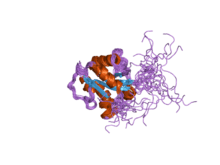Toll-Interleukin receptor
The Toll/interleukin-1 receptor (TIR) homology domain is an intracellular signaling domain found in MyD88, interleukin-1 receptors, Toll receptors and many plant R proteins. It contains three highly conserved regions, and mediates protein-protein interactions between the Toll-like receptors (TLRs) and signal-transduction components. TIR-like motifs are also found in plant proteins thought to be involved in resistance to disease. When activated, TIR domains recruit cytoplasmic adaptor proteins MyD88 (UniProt Q99836) and TOLLIP (Toll interacting protein, UniProt Q9H0E2). In turn, these associate with various kinases to set off signaling cascades.
| TIR domain | |||||||||
|---|---|---|---|---|---|---|---|---|---|
 Structure of the MyD88 TIR domain | |||||||||
| Identifiers | |||||||||
| Symbol | TIR | ||||||||
| Pfam | PF01582 | ||||||||
| InterPro | IPR000157 | ||||||||
| SCOPe | 1fyv / SUPFAM | ||||||||
| OPM superfamily | 289 | ||||||||
| OPM protein | 2mk9 | ||||||||
| Membranome | 7 | ||||||||
| |||||||||
In Drosophila melanogaster the Toll protein is involved in establishment of dorso-ventral polarity in the embryo. In addition, members of the Toll family play a key role in innate antibacterial and antifungal immunity in insects as well as in mammals. These proteins are type-I transmembrane receptors that share an intracellular 200 residue domain with the interleukin-1 receptor (IL-1R), the Toll/IL-1R homologous region (TIR). The similarity between Toll-like receptors (TLRs) and IL-1R is not restricted to sequence homology since these proteins also share a similar signaling pathway. They both induce the activation of a Rel type transcription factor via an adaptor protein and a protein kinase.[1] MyD88, a cytoplasmic adaptor protein found in mammals, contains a TIR domain associated to a DEATH domain (see InterPro: IPR000488).[1][2][3] Besides the mammalian and Drosophila melanogaster proteins, a TIR domain is also found in a number of plant proteins implicated in host defense.[4] As MyD88, these proteins are cytoplasmic.
Site directed mutagenesis and deletion analysis have shown that the TIR domain is essential for Toll and IL-1R activities. Sequence analysis have revealed the presence of three highly conserved regions among the different members of the family: box 1 (FDAFISY), box 2 (GYKLC-RD-PG), and box 3 (a conserved W surrounded by basic residues). It has been proposed that boxes 1 and 2 are involved in the binding of proteins involved in signaling, whereas box 3 is primarily involved in directing localization of receptor, perhaps through interactions with cytoskeletal elements.[5]
Subfamilies
Human proteins containing this domain
IL18R1; IL18RAP; IL1R1; IL1RAP; IL1RAPL1; IL1RAPL2; IL1RL1; IL1RL2; MYD88; SIGIRR; TLR1; TLR10; TLR2; TLR3; TLR4; TLR5; TLR6; TLR7; TLR8; TLR9; SARM;
References
- Bonnert TP, Garka KE, Parnet P, Sims JE, Mitcham JL, Gerhart MJ, Slack JL, Gayle MA, Dower SK (1996). "T1/ST2 signaling establishes it as a member of an expanding interleukin-1 receptor family". J. Biol. Chem. 271 (10): 5777–5783. doi:10.1074/jbc.271.10.5777. PMID 8621445.
- Dixit VM, Muzio M, Ni J, Feng P (1997). "IRAK (Pelle) family member IRAK-2 and MyD88 as proximal mediators of IL-1 signaling". Science. 278 (5343): 1612–1615. doi:10.1126/science.278.5343.1612. PMID 9374458.
- Anderson KV (2000). "Toll signaling pathways in the innate immune response". Curr. Opin. Immunol. 12 (1): 13–19. doi:10.1016/s0952-7915(99)00045-x. PMID 10679407.
- Van der Biezen EA, Jones JD (1998). "Plant disease-resistance proteins and the gene-for-gene concept". Trends Biochem. Sci. 23 (12): 454–456. doi:10.1016/s0968-0004(98)01311-5. PMID 9868361.
- Bonnert TP, Sims JE, Schooley K, Mitcham JL, Slack JL, Dower SK, Qwarnstrom EE (2000). "Identification of two major sites in the type I interleukin-1 receptor cytoplasmic region responsible for coupling to pro-inflammatory signaling pathways". J. Biol. Chem. 275 (7): 4670–4678. doi:10.1074/jbc.275.7.4670. PMID 10671496.